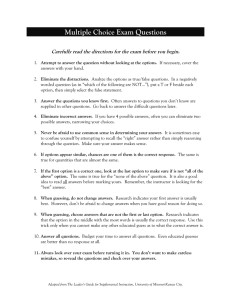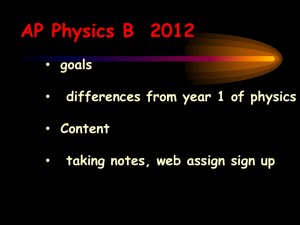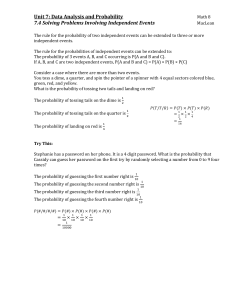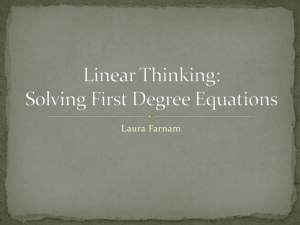DRDO–IISc Programme on Advanced Research in Mathematical Engineering
advertisement
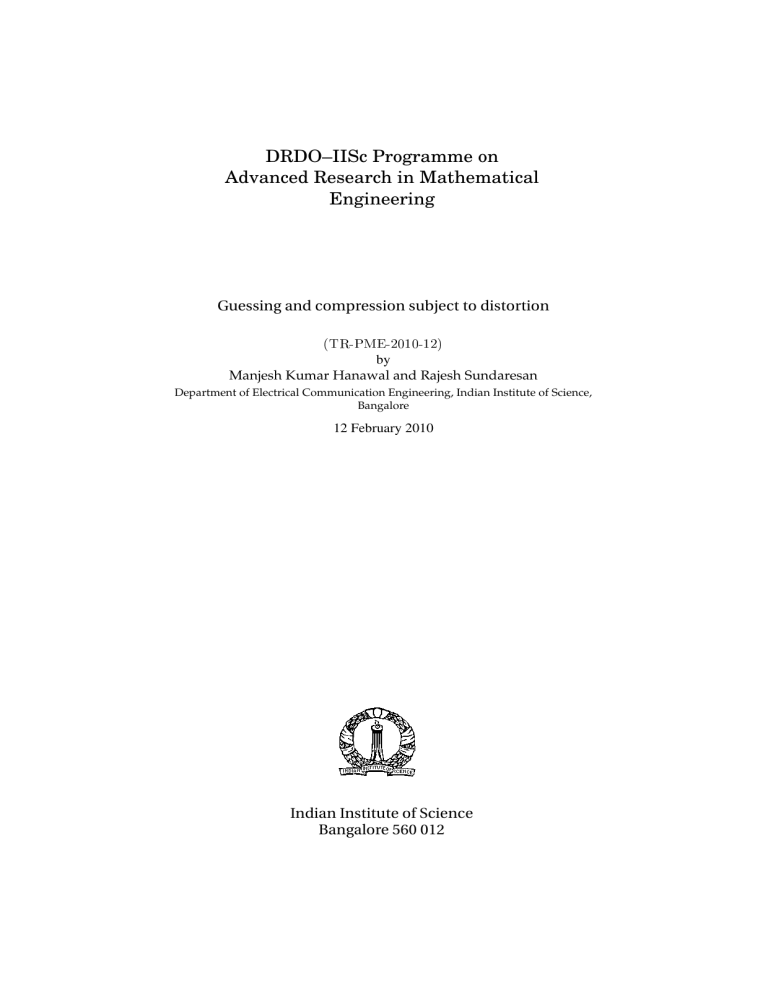
DRDO–IISc Programme on
Advanced Research in Mathematical
Engineering
Guessing and compression subject to distortion
(TR-PME-2010-12)
by
Manjesh Kumar Hanawal and Rajesh Sundaresan
Department of Electrical Communication Engineering, Indian Institute of Science,
Bangalore
12 February 2010
Indian Institute of Science
Bangalore 560 012
Guessing and compression subject to distortion
Manjesh Kumar Hanawal and Rajesh Sundaresan
12 February 2010
ABSTRACT
The problem of guessing a random string is revisited. The relationship between guessing without distortion and compression is extended
to the case when source alphabet size is countably infinite. Further,
similar relationship is established for the case when distortion allowed
by establishing a tight relationship between rate distortion codes and
guessing strategies.
Keywords: compression, distortion, guessing, moment generating function, rate-distortion, quantisation.
1
Introduction
Let X n = (X1 , · · · , Xn ) denote n letters of a random process where each
letter is drawn from a discrete set X. The joint probability mass function
(PMF) is given by (Pn (xn ) : xn ∈ Xn ). Consider a ordered list of guesses
denoted by Gn := {y n (1), y n (2), · · · }. Our interest is in guessing the realisation of a random string by stepping through the elements of Gn . For a given
D ≥ 0, we say Gn is a D-admissible guessing strategy if for each xn ∈ Xn
there is a y n (j) ∈ Gn such that d(xn , y n (j)) ≤ nD, where d(·, ·) denotes a
given distortion measure. The ordered list Gn induces a guessing function
from Xn onto the set of natural numbers denoted by N, i.e., Gn : Xn → N,
and defined by
Gn (xn ) = min {j : d(xn , y n (j)) ≤ nD}, ∀ xn ∈ Xn .
The above model is applicable in search problems such as approximate
pattern matching and database searches where one possesses only partial
information about a target [1] while executing a query. The performance
criterion is the rate of growth of the expected number of guesses as the
length of string being searched grows. Specifically, we wish to evaluate the
optimal exponential growth rate of guessing moments, i.e.,
E(D, ρ) = lim inf
n→∞ Gn
1
1
log E[Gn (X n )ρ ]
n
where ρ is a arbitrary positive real number and infimum is taken over all
D-admissible guessing strategies. The limit above may or may not exist
and an identification of classes of sources for which the limit exists is also of
interest.
Arikan [2] considered the above problem for the case when D = 0, i.e.,
lossless guessing. The optimal guessing strategy in this case is the one which
proceeds in the decreasing order of message probabilities [3], a strategy that
is denoted G∗n . Arikan [2] showed that the guessing exponent exists for
independent and identically distributed (iid) sources taking values on a finite
alphabet set. The limiting exponent is the Rényi entropy of order 1/(1 + ρ).
Sundaresan [4] showed that for any finite alphabet source, the problem
of finding the guessing exponent is the same as that of finding the exponential growth rate for moment generating function for compressed lengths,
a problem proposed by Campbell [5]. This equivalence was established by
associating a length function to each guessing function and vice-versa. One
purpose of this report is to extend these arguments to the case when the
alphabet is countably infinite.
Merhav and Arikan [1] studied the problem of guessing a random string
with D ≥ 0. They showed that the guessing exponent E(D, ρ) exists for
an iid source, among other sources, and commented that a similar method
can be used to solve the compression variant as well (exponents of moment
generating function for compressed lengths). The second purpose of this
report is to make this connection rigorous.
This report is organised as follows. Section 2 considers the lossless case
(D = 0) and X countably infinite. Section 3 addresses D ≥ 0.
2
Guessing without distortion
This section considers the case when X is countably infinite and establishes
equality of exponents of guessing and moment generating functions for compressed lengths. The approach will be nearly the same as that of [4, Sec. 2]
but for a minor technical point which we will resolve.
We shall denote the source by (X n : n ∈ N) with Xi ∈ X, a countably
infinite set. A length function is a mapping Ln : Xn → N such that the Kraft
inequality
X
n
2−Ln (x ) ≤ 1
xn ∈Xn
holds. The engineering interpretation is that Ln (xn ) is the compression
length of the string xn . We first associate a guessing function to each length
function.
Definition 1 Given a length function Ln , the associated guessing function
GLn is the one that guesses strings in the increasing order of Ln -lengths.
2
Strings with the same Ln -lengths are ordered using an arbitrary fixed rule,
say the lexicographical order on X. We also define the associated probability
mass function (PMF) QLn on X to be
n
2−Ln (x )
QLn (x ) = P
.
−Ln (y n )
y n ∈Xn 2
n
¤
The following proposition is a restatement of [4, Prop. 5]. It holds
verbatim even when the source alphabet size is countably infinite, and is
restated here for completeness.
Proposition 1 For a length function Ln and B ≥ 1, the associated guessing
function GLn satisfies the following:
log GLn (xn ) ≤ QLn (xn )−1 ≤ Ln (xn ),
n
n
B
n
n
{x : GLn (x ) ≥ 2 } ⊆ {x : L(x ) ≥ B}.
(1)
(2)
¤
We next associate a length function to every guessing function as follows.
Definition 2 Given any guessing function Gn and δ > 0, we say QGn
defined by
QGn (xn ) = cn (δ)−1 · Gn (xn )−1−δ , ∀xn ∈ Xn
(3)
is the PMF associated with Gn . The quantity cn (δ) is the normalisation
constant. We say LGn defined by
LGn (xn ) = d− log QGn (xn )e, ∀xn ∈ Xn
is the length function associated with Gn .
¤
Observe that for any δ > 0, we have
∞
X
1
cn (δ) =
< ∞,
1+δ
i
i=1
and hence the PMF QGn is well defined. Similar to Proposition 2 in [4] we
state the relation between associated quantities in the following proposition.
3
Proposition 2 To each guessing function Gn , there exists a length function
LGn such that ∀ xn ∈ Xn and δ > 0
LGn (xn ) − 1 − log cn (δ)
LGn (xn )
≤ log Gn (xn ) ≤
.
1+δ
1+δ
¤
Proof: From the definition of LGn we have
LGn (xn ) = d− log QGn (xn )e ≤ 1 + log(cn (δ) · Gn (xn )1+δ ).
Rearranging the above we get
LGn (xn ) − 1 − log cn (δ)
≤ log Gn (xn ).
1+δ
Furthermore, because of (3) and the fact that cn (δ) > 1
log Gn (xn )1+δ ≤ − log QGn (xn ) ≤ d− log QGn (xn )e = LGn (xn ),
which concludes the proof.
The following corollary to the above proposition follows immediately.
Corollary 3 For any given δ > 0 and B ≥ 1, a guessing function Gn and
its associated length function LGn satisfy
{LGn (xn ) − 1 − log cn (δ) ≥ B} ⊆ {(1 + δ) log Gn (xn ) ≥ B}
⊆ {LGn (xn ) ≥ B}.
¤
Let G∗n denote the optimal guessing strategy. The optimal exponential
growth rate of guessing moments is defined as
1
log E [G∗n (X n )ρ ]
(4)
n→∞ n
when the limit exists. Define the growth rate of moment generating function
for compression lengths to be
h
i
1
n
F (ρ) := lim inf
log E 2ρLn (X )
(5)
n→∞ Ln nρ
E(ρ) := lim
whenever the limit exists [5].
The following proposition establishes that the two limits above are the
same and hence it suffices to study one of them, say the limiting exponential
rate of growth of the moment generating function for compression lengths.
Sufficient conditions in the finite alphabet case for the existence of this
limiting exponent can be found in our prior work [6].
4
Proposition 4 Let ρ > 0. Suppose that the F (ρ) exists and the function
F is continuous at ρ; then E(ρ) exists and equals to F (ρ). Conversely,
suppose E(ρ) exists and the function E is continuous at ρ; then F (ρ) exists
and equals to E(ρ).
Proof: First assume that F (ρ) exists and let ρ0 = ρ/(1 + δ). For each
0
² > 0 there then exists a length function Ln such that the following sequence
of inequalities holds:
h
i
h 0 ni
n
inf log E 2ρLn (x ) + ² ≥ log E 2ρLn (x )
Ln
h
i
≥ log E GL0 (xn )ρ
(6)
n
≥ log E [G∗n (xn )ρ ]
(7)
h 0
i
n
≥ log E 2ρ LG∗n (x ) − ρ0 (1 + log cn (δ))
(8)
h 0
i
n
≥ inf log E 2ρ Ln (x ) − ρ0 (1 + log cn (δ)) (9)
Ln
0
In inequality (6), GL0 is the guessing function associated with Ln and obn
tained by applying Proposition 1. Inequality (7) is obtained by noting that
G∗n is the optimal guessing function. In (8), LG∗n is the length function associated with G∗n and we applied Proposition 2. Finally, inequality (9) follows
after taking infimum.
After normalising both sides of (7) by n, taking limit superior on both
sides, and observing that cn (δ) is finite, we have
F (ρ) = lim sup inf
n→∞
Ln
h
i
1
1
n
log E 2ρLn (x ) ≥ lim sup log E [G∗n (xn )ρ ] .
n
n→∞ n
(10)
Similarly, normalising both sides of (9) by n and taking limit inferior on
both sides yields
lim inf
n→∞
h 0
i
1
1
n
log E [G∗n (xn )ρ ] ≥ lim inf inf log E 2ρ Ln (x ) = F (ρ0 ).
n→∞ Ln n
n
(11)
Inequalities (10) and (11) and the assumption that
lim F (ρ0 ) = F (ρ)
δ→0
show that E(ρ) exists and equals F (ρ).
To prove the converse, assume that E(ρ) exists. Consider the following
5
chain of inequalities:
h 0
i
n
log E [G∗n (xn )ρ ] ≥ log E 2ρ LG∗n (x ) − ρ0 (1 + log cn (δ))
h 0
i
n
≥ inf log E 2ρ Ln (x ) − ρ0 (1 + log cn (δ))
Ln
h 0 0 ni
≥ log E 2ρ Ln (x ) − ² − ρ0 (1 + log cn (δ))
h
i
0
≥ log E GL0 (xn )ρ − ² − ρ0 (1 + log cn (δ))
n
h
0i
0
∗ n ρ
≥ log E Gn (x ) − ² − ρ (1 + log cn (δ))
(12)
(13)
(14)
(15)
(16)
In inequality (12), LG∗n is the length function associated with G∗n and we
0
used Proposition 2. In (14), ² is arbitrary positive number and Ln is some
length function depending on this ²; its existence is assured by the definition
0
of the infimum. In (15), GL0 is the guessing function associated with Ln and
n
we used Proposition 1. Finally, (16) is obvious from the use of the optimal
guessing strategy.
Normalising both sides of (13) by n, taking limit superior on both sides,
we have
h 0
i
1
1
n
E(ρ) = lim sup log E [G∗n (xn )ρ ] ≥ lim sup inf log E 2ρ Ln (x ) . (17)
n→∞ Ln n
n→∞ n
Similarly, normalising both sides of (16) by n and taking limit inferior on
both sides, we get
h 0
i
h
i
1
1
n
0
lim inf inf log E 2ρ Ln (x ) ≥ lim inf log E G∗n (xn )ρ = E(ρ0 ). (18)
n→∞ Ln n
n→∞ n
From inequalities (17) and (18) and the continuity assumption of E in ρ,
i.e.,
lim E(ρ0 ) = E(ρ),
δ→0
we conclude that F (ρ) exists and equals E(ρ).
3
Guessing with distortion
We now consider the case when the goal is to guess within a distortion D of
the actual realisation. Let us fix a distortion metric d : X × X → R+ . Recall
that
Definition 3 For a given distortion D and distortion measure d(·, ·), an
ordered list Gn = {y n (1), y n (2), · · · } is a D-admissible guessing strategy if
Pr{d(X n , y n (j)) ≤ nD, for some j} = 1.
¤
6
Also recall that the D-admissible guessing list Gn induces a guessing
function
Gn : Xn → N.
(If Gn is not D-admissible, we set Gn (xn ) = ∞ for all xn with d(xn , y n ) > nD
for each y n ∈ Gn .
Definition 4 A rate distortion code (RDC) is a triple (Cn , fn , Ln ) defined
as follows. Cn is a subset of Xn . The function fn : Xn → Cn is such that
for each xn ∈ Xn there exists a y n ∈ Cn satisfying d(xn , y n ) ≤ nD. The
dependence on D is implicit and understood. Ln : Cn → N is a length
function that satisfies Kraft’s inequality; Ln (xn ) denotes the length of the
encoding for an element xn ∈ Cn .
We now associate a D-admissible guessing strategy and a guessing function to an RDC.
Definition 5 Given an RDC φ = (Cn , fn , Ln ), let Gn order the elements of
Cn in the increasing order of the compression Ln lengths. This shall be the
associated D-admissible guessing strategy. The induced guessing function
is denoted by GLn . We also define the associated probability mass function
(PMF) QLn on Cn to be
n
2−Ln (y )
,
QLn (y ) = P
−Ln (cn )
cn ∈C n 2
n
∀y n ∈ Cn .
¤
The following proposition is similar to Proposition 1.
Proposition 5 For a given rate distortion code (Cn , fn , Ln ) and B ≥ 1,
the associated guessing function GLn satisfies the following:
log GLn (xn ) ≤ QLn (f (xn ))−1 ≤ Ln (f (xn ))
{xn : GLn (xn ) ≥ 2B } ⊆ {xn : L(f (xn )) ≥ B}.
¤
The proof is obviously analogous to that of Proposition 1 and is therefore
omitted.
We now associate an RDC to any D-admissible guessing strategy.
7
Definition 6 Given a guessing function Gn induced by a D-admissible guessing strategy Gn , and given a δ > 0, let Cn = Gn , let fn be the function
that maps xn to the first element y n in the ordered list Gn that satisfies
d(xn , y n ) ≤ nD. Further, define a length function Ln on Cn as in definition
2. We say (Cn , fn , Ln ) is an RDC associated with the guessing function Gn .
¤
The following proposition establishes the relationship between the associated quantities defined above. The proof is very similar to that of Proposition 2 and is therefore skipped.
Proposition 6 Let Gn be a guessing function associated with a D-admissible
guessing strategy. There exists an RDC (Cn , fn , Ln ) such that ∀ xn ∈ Xn
and δ > 0
LGn (fn (xn )) − 1 − log cn (δ)
LGn (f (xn ))
≤ log Gn (xn ) ≤
.
1+δ
1+δ
¤
We now establish a relationship between the guessing exponent and the
exponent of moment generating function for compression lengths, under the
distortion setting. For D ≥ 0 and ρ > 0, define the optimal exponential
growth rate of guessing moments to be
E(D, ρ) := lim inf
n→∞ Gn
1
log E[Gn (X n )ρ ],
n
(19)
whenever the limit exists, where the infimum is taken over all D-admissible
guessing strategies Gn with Gn the associated guessing function. Similar to
(5), define the exponent of the moment generating function for compression
lengths (with distortion) as
F(D, ρ) := lim
inf
n→∞ (cn ,fn ,Ln )
1
n
log E[2ρLn (X ) ],
nρ
(20)
whenever the limit exists, where the infimum is taken over all RDC codes
with distortion within D.
Under the above definitions, we now have the following result analogous
to Proposition 4.
Proposition 7 Let D ≥ 0 and ρ > 0. Suppose that the F(D, ρ) exists and
is continuous at ρ, then E(D, ρ) exists and equals to F(D, ρ). Conversely,
suppose E(D, ρ) exists and is continuous at ρ, then F(D, ρ) exists and equals
to E(D, ρ).
¤
8
The proof of the above proposition is easy following the proof of Proposition 4.
We have thus established that the limiting guessing exponent, subject
to distortion, and the problem of identifying the exponent of the moment
generating function for compressed lengths, again subject to distortion, are
identical.
Acknowledgements This work was supported by the Defence Research
and Development Organisation, Ministry of Defence, Government of India,
under the DRDO-IISc Programme on Advanced Research in Mathematical
Engineering.
References
[1] E. Arikan and N. Merhav, “Guessing subject to distortion,” IEEE Trans. Inf. Theory,
vol. 44, pp. 1041–1056, May 1998.
[2] E. Arikan, “An inequality on guessing and its application to sequential decoding,”
IEEE Trans. Inf. Theory, vol. 42, pp. 99–105, Jan. 1996.
[3] J. L. Massey, “Guessing and entropy,” in Proc. 1994 IEEE International Symposium
on Information Theory, Trondheim, Norway, Jun. 1994, p. 204.
[4] R. Sundaresan, “Guessing based on length functions,” in Proceedings of the Conference
on Managing Complexity in a Distributed World, MCDES, Bangalore, India, May
2008; also available as DRDO-IISc Programme in Mathematical Engineering Technical
Report No. TR-PME-2007-02, Feb. 2007.
http://pal.ece.iisc.ernet.in/PAM/tech rep07/TR-PME-2007-02.pdf.
[5] L. L. Campbell, “A coding theorem and Rényi’s entropy,” Information and Control,
vol. 8, pp. 423–429, 1965.
[6] M. K. Hanawal and R. Sundaresan, “Guessing revisited: A large deviations approach,”
in Proc. National Conference on Communications, Guwahati, India, Jan 2009.
9
